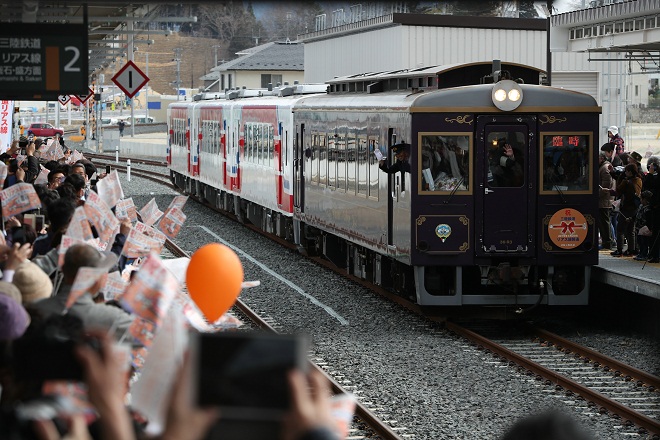Tsunami-damaged train line reopens after 8 years
March 24, 2019
Yamada, Iwate Pref.--A railway line section in the Tohoku northeastern Japan region reopened on Saturday after an eight-year shutdown caused by damage from the March 2011 earthquake and tsunami.
Operations of the section between Miyako and Kamaishi stations in Iwate Prefecture have been transferred to Sanriku Railway Co., a public-private company based in the Iwate city of Miyako, from East Japan Railway Co. <9020>, or JR East.
The section, which was part of the JR Yamada Line before the transfer, links up with Sanriku Railway's two existing lines at its northern and southern ends, forming a 163-kilometer coastal railway line, called the Riasu Line.
Around 11:40 a.m. (2:40 a.m. GMT), many local residents celebrated the departure of a special commemorative train from the Kamaishi station on the platform and along the railroad line, waving fishing boat flags and by other means.
The Riasu Line is scheduled to start commercial services Sunday.
"This day has finally come," Sanriku Railway President Ichiro Nakamura said, referring to the day's resumption as "the third start" for his company following the 1984 launch of the original two lines and the reopening of the two lines, both heavily damaged by the tsunami.
Takuto Yoshida, a 17-year-old second-year student at the Kamaishi commercial and technical high school, who took part in the departing ceremony, said, "It'll be convenient as trains are fast and punctual."
"I'm looking forward to getting on," Yoshida added.
Chiyako Ueyama, a 55-year-old resident of the Iwate town of Otsuchi, said, "It's good new stations have been built."
On the reopened section, a total of 8.5 kilometers were flooded by the tsunami. Seven station buildings and six bridges were also damaged.
In December 2014, JR East and local municipalities agreed to transfer the operations of the section to Sanriku Railway. Restoration work finished by December last year.
Two stations have been newly built in Miyako, where the population is rising thanks to the establishment of public housing for disaster-afflicted people.
The number of Sanriku Railway train passengers dropped to 510,000 in fiscal 2016 from 2.68 million in fiscal 1984, chiefly owing to the March 2011 disasters and depopulation of nearby areas.
Meanwhile, the company's Kita-Riasu line, one of the original lines, was seen as a symbol of postdisaster reconstruction because its operations were partially resumed only five days after the disasters.
More ceremonies to mark the launch of the Riasu Line will be held on Sunday after a "toramai" traditional dance performance at the Unosumai station in Kamaishi on Saturday. Jiji Press
Latest Videos
- THE UNTOLD STORY EXPERT INSIGHTS INTO THE UKRAINE
- NEGOTIATING A NEW ORDER US RUSSIA TALKS ON UKRAIN
- Ukraine: A Pawn in the Geopolitical Game? Will Trump Intervene?
- US VP VANCE CRITICIZES EUROPEAN DEMOCRACIES AT MUNICH SECURITY CONFERENCE
- UNCOVERING THE WEB OF DECEIT: CIA INFILTRATION OF THE MEDIA
- SHIFTING SANDS: TULSI GABBARD’S CONFIRMATION AND THE EVOLVING GLOBAL LANDSCAPE
- FAUCI SCANDAL: A THREAT TO GLOBAL HEALTH AND DEMOCRACY






